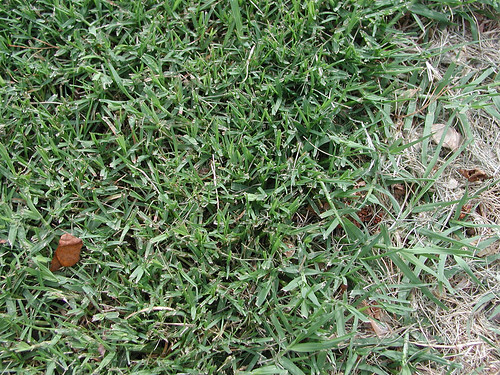Resource Library
Plant of the Week: Cynodon dactylon, Bermudagrass
I’m not much of a lawn guy. Yes, a well tended, green, lush lawn is a thing of beauty and a wonderful addition to any landscape, but lawns just don’t inspire me. Of all the lawn grass species, bermudagrass (Cynodon dactylon) is by far the most widely encountered and toughest, but gardeners have a love-hate relationship with it.
Bermudagrass is a fast growing warm season perennial grass that spreads rapidly by seed, underground rhizomes and surface stolons (runners). If left unmowed plants can reach two feet high in moist, rich sites, but it also tolerates close mowing for use in lawns. Plants spread rapidly, and can make 3 feet or more of horizontal growth in a season. Rhizomes grow deep, often being found at 6 inches down if the soil is sufficiently friable.
Bermudagrass greens up in mid spring and grows until the first frost. Its summertime color is a rich green with a wintertime appearance of weathered straw. Flowering awns are produced during the growing season and are purplish in color with five or six arms radiating from a slender stem held six inches above the foliage.
Like many of our early introduced weeds and plants, the origins of bermudagrass is lost in the fog of history. Probably the plant originated as bedding brought in with the slave trade from southeastern Africa, but the plant is so ubiquitous throughout the tropical world it is hard to know for sure.
Probably the name “Bermuda” refers to the Island by the same name but the grass is not believed to be native there. It was first used — and still is — as a productive and reliable forage crop. It was reported as growing here by 1751, but its use as a lawn and on golf courses is more recent, beginning about 100 years ago. The strains of Bermuda used in lawns began to appear in the late 1940’s and came from breeding work in Georgia, and later Florida and Texas.
The wild growth rate of bermudagrass is due to the physiology of the plant. It is a “C4” plant, meaning it has the new and improved form of photosynthesis. In the normal (and presumably original) form of photosynthesis, carbon is fixed into three carbon unit strands (C3 plants) and growth proceeds at a respectable but modest rate. But C4 plants have a propensity to fix carbon rapidly as long as there is an ample amount of sunlight and sufficient heat.
Being a tropical and semi-tropical grass, bermudagrass is only winter hardy about as far north as central Missouri (zone 6), and even there it will sometimes winterkill during bad years. In Arkansas it is almost always winter hardy and is the default (along with crabgrass and other assorted weeds) for anyone with a sunny lawn who just mows their patch of greenery.
With weed control and fertilization, it is relatively easy to convert one of these weedy patches into a respectable bermudagrass lawn. The lawn care industry has proliferated in the state in recent years and is well equipped to make that happen.
But for gardeners bermudagrass lawns can be an anathema. Yes, this tough grass does a wonderful job of providing a dependable lawn surface, but bermudagrass’s tendency to invade all adjacent flower beds, vegetable gardens and borders makes it a challenge to maintain. If you are a lawn person it is a great choice; if your interest lies in other directions, it is probably better to look for an alternative or not encourage it by treating it too nicely.
For more information about horticulture or to see other Plant of the Week columns, visit Extension’s Website, www.uaex.uada.edu, or contact your county extension agent. The Cooperative Extension Service is part of the U of A Division of Agriculture.
Pursuant to 7 CFR § 15.3, the University of Arkansas System Division of Agriculture offers all its Extension and Research programs and services (including employment) without regard to race, color, sex, national origin, religion, age, disability, marital or veteran status, genetic information, sexual preference, pregnancy or any other legally protected status, and is an equal opportunity institution.
